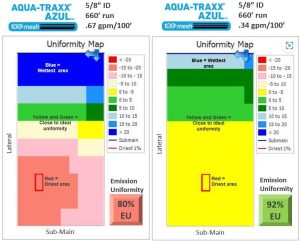Source: Penn State Extension
Many greenhouse and nursery operations use fertilizer injectors, also known as proportioners, to deliver precise concentrations of water-soluble nutrients to plants through irrigation systems. Injectors pull a concentrated fertilizer solution from a stock tank and add it to the irrigation water.

Because proper fertilization of greenhouse crops is essential for producing top-quality plants, it is very important to mix stock solutions to the proper concentration for each injector ratio.
Ounces per gallon, injector ratios, parts per million, dilution factors, conversion constants…is this another hateful word problem from grade school math class? Often when people are faced with what seem like complicated calculations, such as how to mix up a stock solution of the correct solution for a fertilizer injection setting, they may feel overwhelmed and lose confidence that they can arrive at the right answer. Let’s demystify this by breaking down the problem into manageable steps.
Start by defining the problem
What do you know? What do you need to know? To mix a stock solution, you will need to know the following:
- Desired concentration of the nutrient. Usually this is in parts per million, or ppm, and nitrogen is often the nutrient in question.
- Injector ratio. That is the number that looks like 1:100 or 1:300 or even 1:1200. Many injectors have dials so that you can adjust the injector ratio, at least within the range of the injector model.
- Dilution factor. This is an easy one; it is the larger number in the injector ratio number (i.e. the number following the 1).
- Fertilizer analysis. The fertilizer product must have a label showing the analysis, for example 20-10-20 or 17-5-24. The first number is the percentage by weight of nitrogen (N); the second is the percentage of phosphorus (P) as P2O5; and the third is the percentage of potassium (K) as K20.
- Ounces of fertilizer to make one gallon of stock solution. This is what you are trying to figure out so you can mix the proper concentration of fertilizer.
Three approaches to calculations
Use the fertilizer label. Packages of soluble fertilizer almost always contain a table which specifies how much product to use for a given fertilizer concentration. The tables show the ounces of fertilizer needed for a range of nutrient concentrations (e.g. 25-400 ppm nitrogen) and for a range of injector ratios (e.g. 1:15 through 1:300). So if the stock solution you need to mix up falls under the parameters of the table, then there is no need for further calculations. However, you may find times when the stock solution you need to mix for a given application and injector ratio is not defined by the product tables. Then you will need to do some calculations, either by hand or using an online calculator.
Calculate based on the percentage of nutrient in the fertilizer.
A useful formula for calculating how many ounces of dry soluble fertilizer are needed to make 1 gallon of stock solution is as follows.
(Desired concentration in ppm X Dilution factor) / (% of element in fertilizer X 75)
For example, if your injector ratio is 1:200 (so the dilution factor is 200), your fertilizer analysis is 17-5-24, and you want to apply 150 ppm nitrogen:
(150 X 200) / (17 X 75) = 23.53 ounces, or round up to 23.5
In this formula, the 75 is a conversion constant for the units of ppm, ounces and gallons. Note that this formula is useful if your calculation is based on P, K, or Ca, rather than N, but make sure you first calculate the actual percentages of P or K by weight, since the fertilizer analysis (17-5-24) gives these two nutrients in terms of percentage of P205 and K20.
Use an online calculator. Some manufacturers of injectors have online calculators posted on their websites for quick and accurate calculations. For example, you can type in the ppm required, % of N, injection ratio, and stock tank size into Dosatron’s calculator for water soluble fertilizer and immediately get the answer to how much fertilizer is needed for the stock solution. This site also offers calculators for liquid fertilizers, water soluble powders, and other options.
Weigh out the fertilizer–or maybe not
If you are mixing up a relatively small amount of stock solution, such as a gallon or two, you will need an accurate scale to weigh out the fertilizer for the stock solution. However, if you use larger quantities of the stock solution, you may be able to skip weighing the fertilizer by calculating how many gallons one entire package of fertilizer will make. For example, since there are 16 ounces in a pound, then a 25 lb bag of fertilizer contains 400 ounces. Using the example above, we simply divide 400 oz by 23.5 oz/gallon to determine how many gallons of stock solution can be prepared using an entire bag of fertilizer. In this case, one bag of fertilizer will make 17 gals of stock solution.
Final Considerations
Making sure that the stock solution is prepared correctly and is the proper concentration is just one step in assuring that your crops are receiving the correct nutrient feed. It is important to confirm the injector ratio, either by performing a calibration, or by checking the EC of the irrigation water and comparing it with the expected ECs provided on fertilizer product charts. And for best results, we highly recommend following the manufacturer’s schedule for injector maintenance and replacement.
Original post by Lee Stivers via Penn state Extension




